28 Amazing Things That Oaxaca Is Known For [2024]
Disclosure: This post may contain affiliate links, meaning that I may get a small commission if you decide to make a purchase through my links, at no cost to you.
What is Oaxaca known for? So many things!
It is known for its rich cultural heritage, its beautiful colors everywhere, its wonderfully friendly people, its breathtaking landscapes, and its mouthwatering cuisine.
It has buildings that are centuries old and ruins that are thousands of years old.
Oaxaca is known for its traditional festivals, a vibrant artistic scene, wonderful markets, and brilliant artisans of all kinds. True wonders of the world are literally just a short drive away from Oaxaca de Juarez.
It is rare indeed to find a region as richly diverse as Oaxaca. The only difficulty you have is that unless you are very fortunate, you probably won’t be able to stay long enough to see and do everything.
In this article, we show you 28 things that make Oaxaca truly unique and unforgettable. Read on and find out why Oaxaca is a must-visit destination on any traveler’s bucket list.
Amazing things Oaxaca is known for
Amazing things Oaxaca is known for
1. Oaxacan Cuisine
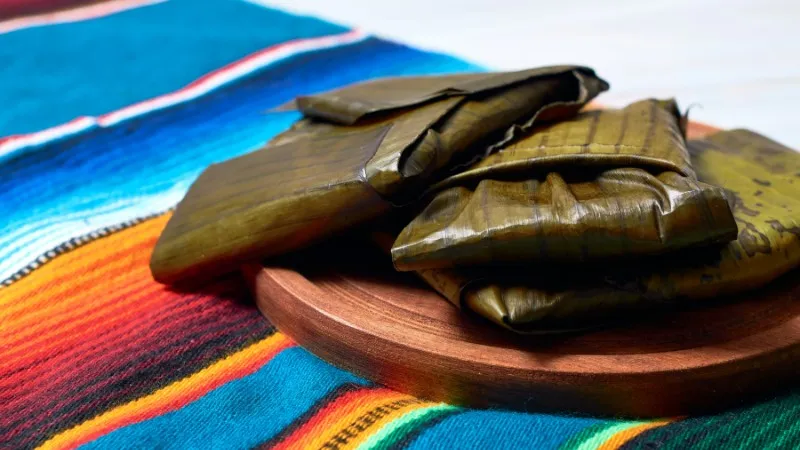
Perhaps more than anything else, Oaxaca is known for its diverse cuisine.
Its diverse culinary tradition reflects the rich cultural heritage of Oaxaca itself, which draws on the pre-Hispanic Zapotec and Mixtec cultures, and the Spanish culture brought to the region in colonial times.
This rich heritage has resulted in Oaxaca standing out as a prominent pillar of Mexican gastronomy. It is renowned for its depth of flavor, intricate preparation methods, and vibrant ingredients.
One of the most iconic elements of Oaxaca cuisine is mole, a complex and velvety sauce made with a blend of chilies, spices, and other secret ingredients. The region is home to several mole varieties, each with its distinct characteristics and taste profiles.
Tlayudas are another specialty that Oaxaca is known for. Tlayudas are large, crispy tortillas topped with beans, cheese, and an array of savory ingredients. They are a staple of Oaxacan street food and a favorite among locals and visitors alike.
Oaxacan cuisine also features a plethora of traditional dishes. These include memelas, a type of thick tortilla topped with beans, cheese, and salsa, and tamales wrapped in banana leaves, filled with meat or other delightful ingredients.
The region’s cuisine also celebrates the use of indigenous ingredients, such as chapulines. Chapulines are toasted grasshoppers that add a unique and crunchy texture to various dishes, showcasing the region’s deep-rooted culinary traditions.
Another prominent aspect of Oaxacan cuisine is its artisanal mezcal production. Mezcal is a distilled spirit made from agave that is deeply intertwined with Oaxacan culture and is cherished for its smoky and earthy flavors.
Oaxaca is also known for its vibrant markets that offer an array of fresh produce, aromatic spices, and handcrafted textiles. The bustling markets provide bountiful choice for local merchants to buy and sell their wares, and also provide an immersive experience for visitors.
Oaxaca cuisine is a mosaic of exquisite flavors, regional specialties, and indigenous ingredients that paint a vivid picture of the region’s rich cultural identity. More than anything else, its wonderful food and drink it what Oaxaca is famous for.
Amazing things Oaxaca is known for
2. Day of the Dead (Día de Muertos)

The Day of the Dead, known as “Día de Muertos,” is a vibrant and deeply meaningful celebration held annually in Oaxaca. Although celebrated throughout Mexico, Oaxaca is known for its particularly traditional and colorful expression of the celebration.
This ancient tradition, recognized by UNESCO as an Intangible Cultural Heritage of Humanity, honors and remembers deceased loved ones while embracing the belief that death is a natural part of life’s cycle.
The festivities typically take place between October 31st and November 2nd, aligning with the Catholic holidays of All Saints’ Day and All Souls’ Day. During this time, Oaxacan communities come alive with colorful altars, elaborate decorations, and solemn yet joyful gatherings.
Central to the celebration are the elaborately decorated altars, or “ofrendas,” which are constructed in homes, public spaces, and cemeteries.
Ofrendas are thoughtfully arranged with an array of offerings, including the deceased’s favorite foods, beverages, and other personal belongings. Marigold flowers, known as “cempasúchil,” are used to adorn the altars and create a path for the souls to find their way back to the living world.
Families also place photographs of their departed loved ones on the ofrendas, along with candles, incense, and other symbolic items. It is believed that during Día de Muertos, the souls of the departed return to the earthly realm to reunite with their families and partake in the offerings.
In cemeteries throughout Oaxaca, families gather to clean and decorate the gravesites of their ancestors. They spend the night at the cemetery, reminiscing about the memories shared with their loved ones, praying, and singing songs. The atmosphere is one of reverence and celebration, as the living and the dead are believed to be united during this special time.
A significant aspect of Oaxacan Day of the Dead is the creation of “calaveras,” or sugar skulls. These edible works of art are intricately decorated with colorful icing and are often personalized with the names of the deceased. Calaveras serve as both a sweet treat and a symbol of the playful and humorous approach to death in Mexican culture.
The celebration also includes lively parades and processions, with people dressed in colorful costumes and traditional attire. The streets come alive with music, dance, and vibrant displays of cultural pride. The imagery of skeletons and skulls, often portrayed in a humorous and whimsical manner, represents the Mexican belief that death is not to be feared but embraced as a natural part of life’s journey.
Oaxacan Day of the Dead is more than just a festival. It is a profound expression of cultural identity and a way for families to honor and remember their ancestors. The tradition fosters a sense of community and solidarity, as people come together to share stories, memories, and the love they hold for those who have departed.
Amazing things Oaxaca is known for
3. Monte Albán
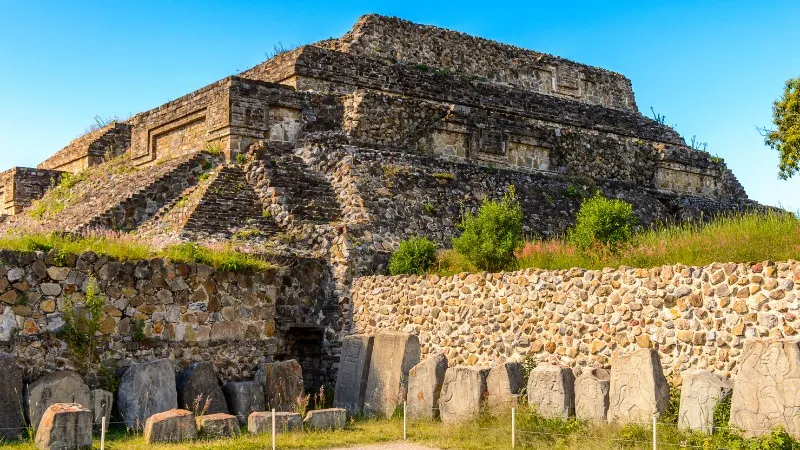
Monte Albán is an ancient archaeological site situated approximately 5.6 miles (9 kilometers) west of Oaxaca de Juarez. Although there are a number of archaeological ruins near the city, Monte Albán is the site that Oaxaca is known for most.
Perched atop a mountain at an elevation of about 1,940 meters (6,365 feet) above sea level, Monte Albán commands a breathtaking view of the surrounding valleys and mountains, making it a strategic and commanding location for its construction.
The site’s origins can be traced back to around 500 BC when the Zapotec people began to establish the city. Over time, it evolved into a flourishing metropolis and served as the capital of the Zapotec civilization until its eventual decline and abandonment around 850 AD.
The architectural layout of Monte Albán showcases the sophisticated urban planning and engineering skills of the Zapotec civilization.
Its vast central plaza, known as the Great Plaza, is bordered by monumental structures, including the South Platform and North Platform, which were used for religious and ceremonial purposes. The Ball Court, situated to the east of the Great Plaza, reflects the significance of ritualistic and sporting activities in Zapotec culture.
Among the prominent structures are the Pyramid of the Sun and Pyramid of the Moon, both dedicated to religious rituals and deities. The observatory structure, Building J, located on the North Platform, demonstrates the Zapotec’s advanced knowledge of astronomy and celestial alignments.
The site also features remarkable tombs, such as Tomb 104, adorned with intricate murals and hieroglyphs, providing insights into ancient Zapotec burial practices and beliefs.
One of the most striking elements at Monte Albán is the collection of carved stone monuments known as the Danzantes. These depict human figures in contorted positions, serving as a unique form of communication or artistic expression.
The city’s eventual decline and abandonment remain subjects of scholarly debate, with theories ranging from political unrest to environmental challenges. Today, Monte Albán is a UNESCO World Heritage Site and an essential destination for history enthusiasts, archaeologists, and curious travelers eager to explore the ancient wonders of Oaxaca.
With its relative proximity to Oaxaca City, visiting Monte Albán offers a convenient and enlightening day trip. The site’s historical significance, stunning views, and well-preserved archaeological structures provide a captivating window into the fascinating world of the ancient Zapotec civilization and its enduring legacy in the heart of Oaxaca.
Amazing things Oaxaca is known for
4. Hierve el Agua

Hierve el Agua is a breathtaking natural wonder located approximately 70 kilometers (43 miles) southeast of Oaxaca. This unique geological formation of petrified waterfalls and stunning mineral springs attracts both locals and tourists seeking a one-of-a-kind experience that Oaxaca is known for.
The name “Hierve el Agua” translates to “the water boils,” which is a misnomer as the water is not actually boiling. The site is formed by natural mineral deposits over thousands of years, creating cascading terraces of calcium carbonate that resemble frozen waterfalls. The mineral-laden water flows over the cliffs, leaving behind these stunning formations, making it one of the most remarkable sights in Oaxaca.
The age of Hierve el Agua is estimated to be around 2,000 years old, making it a site of both geological and historical significance. The Zapotec people, the indigenous inhabitants of the region, once considered Hierve el Agua sacred and believed that the petrified waterfalls were the result of ancient gods’ tears.
Visitors to Hierve el Agua can enjoy the natural infinity pools that form on the edge of the petrified waterfalls. These pools offer a unique opportunity to swim in mineral-rich waters while taking in the panoramic views of the surrounding valleys and mountains.
The site is also home to a small archaeological zone, where remnants of ancient structures and terraces can be explored. Archaeological evidence suggests that Hierve el Agua was once a ceremonial center and an important agricultural site for the ancient Zapotec civilization.
To reach Hierve el Agua from Oaxaca, visitors can take a scenic drive through the picturesque Oaxacan countryside, passing through rural villages and enjoying stunning landscapes. The journey to the site adds to the overall experience, providing a glimpse of the natural beauty that Oaxaca is known for.
Today, Hierve el Agua is managed as an eco-tourism destination, and efforts are made to preserve its ecological balance and cultural significance. Visitors are encouraged to respect the environment and the historical value of the site while enjoying its natural splendor.
For nature lovers, adventure seekers, and history enthusiasts, a visit to Hierve el Agua is an unforgettable experience. The awe-inspiring petrified waterfalls, the serene infinity pools, and the rich historical heritage that Oaxaca is known for combine to create a unique destination that showcases the remarkable diversity of natural and cultural treasures of this picturesque region.
Amazing things Oaxaca is known for
5. Mezcal

Mezcal is a renowned and cherished spirit that Oaxaca is known for and that is deeply rooted in Oaxaca’s cultural heritage. Distinct from its popular counterpart, tequila, mezcal is made from the heart of the agave plant, known as “piña,” and is crafted through a traditional and artisanal process that dates back centuries.
The production of Oaxacan mezcal starts with the careful selection of agave plants, which are harvested when fully matured, typically taking between 7 to 15 years. The piñas are then roasted in underground pit ovens, giving the mezcal its distinctive smoky flavor. After roasting, the piñas are crushed by stone mills or tahonas, creating a fibrous pulp from which the juice is extracted.
The extracted juice is then fermented naturally, relying on wild yeasts, which contribute to the unique and diverse flavor profiles of Oaxacan mezcal. The fermented liquid is double-distilled in copper or clay pot stills, a process that refines and concentrates the flavors while retaining the spirit’s artisanal character.
One of the cherished aspects of mezcal production that Oaxaca is known for is the commitment to traditional and sustainable practices. Many mezcal producers embrace ancestral techniques passed down through generations, fostering a strong connection to the land and the agave plant.
The agave used in mezcal production varies, leading to a wide range of mezcal expressions with distinctive flavor profiles. Some well-known agave species used in Oaxacan mezcal include Espadín, Tobalá, and Madrecuishe, each imparting unique nuances to the final product.
Oaxacan mezcal is celebrated for its complexity, often featuring notes of smokiness, earthiness, and herbaceous undertones. Connoisseurs appreciate the diverse range of flavors and aromas that distinguish Oaxacan mezcal from other spirits.
The artisanal and small-scale nature of mezcal production that Oaxaca is known for contributes to its premium status among spirits enthusiasts. Each batch of mezcal is a labor of love, reflecting the expertise and passion of the maestro mezcaleros who carefully oversee every step of the production process.
As Oaxacan mezcal gains global recognition, its significance in local culture remains as strong as ever. The spirit is deeply intertwined with traditional celebrations, rituals, and family gatherings, symbolizing unity and community in Oaxacan life.
Oaxacan mezcal is a revered and distinctive spirit, deeply rooted in the traditions and cultural heritage of Oaxaca. Its artisanal production, diverse agave species, and complex flavor profiles make it a captivating and cherished beverage that continues to captivate connoisseurs and enthusiasts worldwide.
Amazing things Oaxaca is known for
6. Barro Negro

Barro Negro or “black pottery” is a distinctive and iconic form of pottery that Oaxaca is known for and that has been produced in the Oaxaca region for centuries. Renowned for its glossy black finish and intricate designs, Barro Negro is a testament to the skill and artistry of Oaxacan artisans.
The origins of Barro Negro can be traced back to the Zapotec civilization, who developed this unique pottery style using traditional techniques. The clay used in Barro Negro is sourced from the region and is known for its high iron content, which gives the pottery its characteristic black color when fired.
The process of creating Barro Negro is intricate and time-consuming. Artisans begin by shaping the clay on a potter’s wheel or by hand, and the pieces are then left to dry in the sun. Once dried, the pottery is meticulously incised with delicate patterns and designs using sharp tools or by impressing patterns with molds.
After the designs are complete, the pottery is fired in a kiln at high temperatures, typically using traditional wood-fired techniques. During the firing process, the oxygen supply is restricted, creating a reduction atmosphere that turns the clay black and produces a glossy finish.
The final result is a stunning piece of pottery that showcases both the simplicity and elegance of Oaxacan Barro Negro. The glossy black surface serves as a canvas for intricate patterns and motifs, ranging from geometric designs to representations of local flora and fauna.
Barro Negro has evolved over the centuries, with modern artisans incorporating contemporary elements into their designs while still preserving the traditional techniques and aesthetics. Today, this distinctive pottery is appreciated not only for its artistic value but also as a reflection of the cultural heritage that Oaxaca is known for.
Barro Negro has become a symbol of Oaxaca’s craftsmanship and is highly regarded by collectors and art enthusiasts worldwide. Visitors to Oaxaca can find Barro Negro pieces in various shapes and sizes, from small decorative items to larger vessels and sculptures.
Beyond its artistic value, Barro Negro plays an essential economic role in the region, providing livelihoods for many families involved in its production. The preservation of this traditional craft is actively supported through artisan workshops, cultural initiatives, and artisan markets.
Barro Negro is a remarkable example of the artistic heritage and cultural identity that Oaxaca is known for. Its glossy black finish, intricate designs, and traditional craftsmanship make it a cherished and celebrated form of pottery that continues to captivate art lovers and travelers alike.
Amazing things Oaxaca is known for
7. Mole
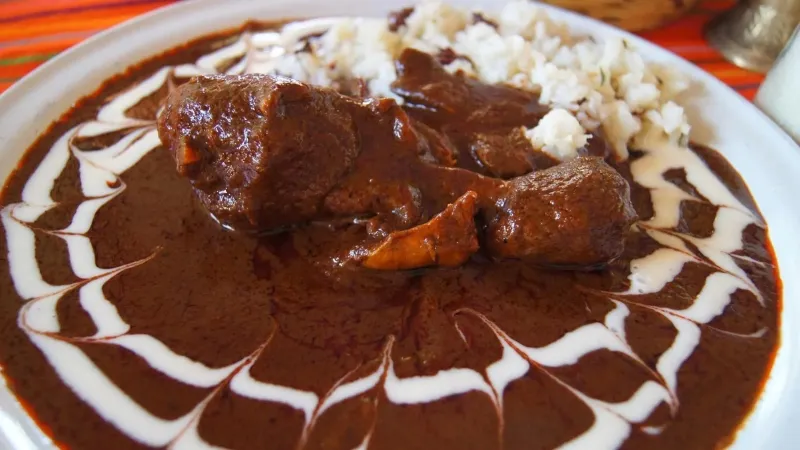
Mole is a renowned and complex sauce that Oaxaca is known for and that holds a significant place in Mexican cuisine. This traditional culinary masterpiece is an integral part of Oaxacan culture, representing the region’s rich history and diverse flavors.
The word “mole” originates from the Nahuatl word “mulli,” meaning sauce or mixture. Oaxacan mole dates back to pre-Hispanic times when indigenous peoples of the region used various ingredients to create flavorful sauces for their meals. Over the centuries, Spanish influence introduced new ingredients and cooking techniques, leading to the development of the moles we know today.
There are seven major varieties of Oaxacan mole, each with its distinct ingredients and characteristics. These include Mole Negro, Mole Rojo, Mole Coloradito, Mole Amarillo, Mole Verde, Mole Chichilo, and Mole Manchamanteles. Each mole is carefully prepared using a combination of chilies, spices, nuts, seeds, and other ingredients, resulting in a sauce with a unique flavor profile.
Mole Negro is perhaps the most famous and complex of all moles. Its deep, dark color comes from blackened chilies and chocolate, giving it a velvety texture and a perfect balance of sweetness and spice. Mole Negro is typically served with turkey or chicken and is a centerpiece of Oaxacan cuisine.
Mole Rojo boasts a rich red color and a robust taste, featuring a blend of dried red chilies, tomatoes, garlic, and spices. Mole Coloradito is characterized by its vibrant red hue and earthy flavor, made from red chilies, tomatoes, and achiote. Mole Amarillo is bright yellow with a tangy taste, crafted from yellow chilies, tomatillos, and ground seeds.
Mole Verde, on the other hand, is a vibrant green mole with fresh herbal flavors, made from a mix of green chilies, tomatillos, cilantro, and epazote. Mole Chichilo stands out for its smoky taste and black color, incorporating ingredients like pasilla chilies, avocado leaves, and blackened tortillas.
Lastly, Mole Manchamanteles, meaning “tablecloth stainer,” is a sweet and savory mole with a fruity undertone, featuring ingredients like ancho chilies, pineapple, plantains, and nuts.
Each variety of mole has its specific pairings, with meats, poultry, and vegetables enhancing the unique flavors of the sauce.
Mole is a labor-intensive dish made from a unique combination of ingredients, resulting in a symphony of tastes that captivates the palate. The process of making mole is both time-consuming and intricate, involving grinding, roasting, and blending multiple ingredients to create a harmonious mixture. Passed down through generations, the preparation of mole is often a family affair and a way to preserve cultural traditions.
Mole is not only celebrated within the region but also recognized internationally for its complexity and deliciousness. The preparation and enjoyment of mole are central to numerous cultural celebrations and festivals in Oaxaca, including weddings, religious events, and important milestones.
Mole is a culinary treasure that Oaxaca is known for and that encapsulates the history, culture, and diversity of the region. Its seven major varieties showcase the craftsmanship and artistry of Oaxacan cooks, who carefully craft each sauce to perfection.
Whether enjoyed at a local market or a fine dining restaurant, Oaxacan mole offers a captivating and unforgettable experience.
Amazing things Oaxaca is known for
8. Tule Tree
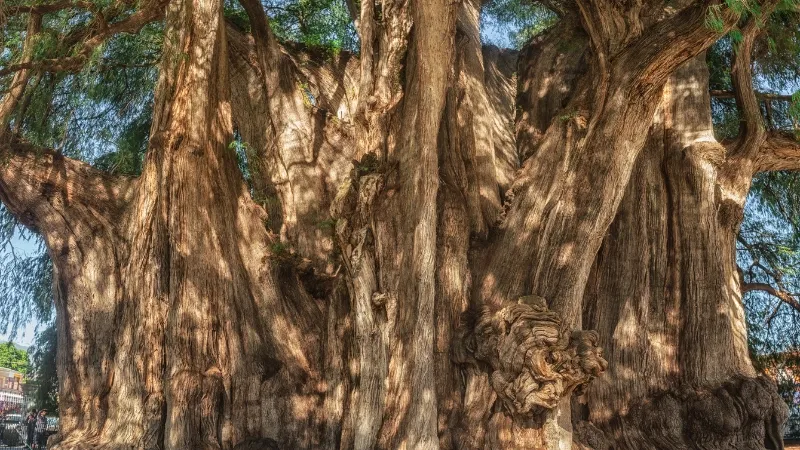
A truly remarkable natural wonder that Oaxaca is known for is the Tule Tree. It is located in the town of Santa María del Tule, a little over six miles (10 kilometers) to the east of Oaxaca de Juarez.
This ancient tree is an impressive example of a Montezuma cypress (Taxodium mucronatum), known locally as “El Árbol del Tule.”
The Tule Tree’s age is estimated to be between 1,200 to 2,000 years old, making it one of the oldest living trees on the planet. It stands as a living testament to the rich history and cultural significance of the region, as it has witnessed centuries of human history and events.
One of the most awe-inspiring aspects of the Tule Tree is its sheer size. It reaches a staggering height of around 40 meters (131 feet) and has a circumference of approximately 42 meters (138 feet). Its massive trunk is adorned with unique, gnarled textures and patterns, showcasing the resilience of nature.
The Tule Tree’s immense presence has made it a symbol of strength and endurance in the local Zapotec community, with many myths and legends surrounding its origin.
According to local folklore, the tree was planted by a priest who transformed a love-stricken woman into the tree as a punishment for her unrequited love. Another legend suggests that the tree is the result of a marriage between the Earth and the sky.
Due to its cultural and historical significance, the Tule Tree has been declared a “living monument” by the Mexican government. It attracts thousands of visitors each year, both locals and tourists alike, who come to marvel at its grandeur and immerse themselves in its ancient aura.
To ensure the preservation of this natural treasure, the tree is carefully tended to by local authorities and experts. Measures have been implemented to protect its health and structural integrity, including pruning and monitoring of potential threats.
Visitors to the Tule Tree can explore the tree and its surrounding gardens, which have been transformed into a pleasant park area. There are also artisan markets nearby, where visitors can shop for traditional handicrafts and souvenirs, further immersing themselves in the local culture.
The Tule Tree in Oaxaca is a living testament to the enduring power of nature and a cherished symbol of cultural heritage that Oaxaca is known for. Its towering presence and ancient age make it an awe-inspiring attraction that captivates all who have the privilege of standing in its shadow.
As a cherished part of Oaxaca’s history and identity, the Tule Tree continues to stand as a living reminder of the region’s cultural richness and the wonders of the natural world.
Amazing things Oaxaca is known for
9. Oaxaca Cheese
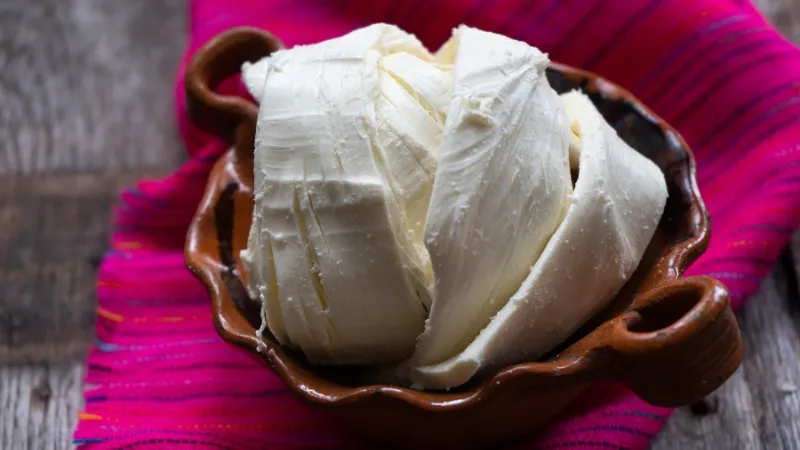
Oaxaca cheese, also known as “quesillo”, is a traditional Oaxacan cheese renowned for its unique stretchy texture and mild, slightly tangy flavor.
Oaxaca cheese holds a special place in Mexican cuisine and is a staple ingredient in various dishes, including quesadillas, tlayudas, and empanadas.
The production of Oaxaca cheese follows traditional methods passed down through generations of local cheesemakers. It is made from cow’s milk and sometimes blended with goat’s milk to add complexity to its taste.
The cheese-making process starts by heating the milk and adding natural coagulants, such as rennet or lemon juice, to separate the curds from the whey. The curds are then stretched and kneaded to form a smooth, elastic texture, giving Oaxaca cheese its signature stringy appearance.
One of the distinctive features of Oaxaca cheese is its “pasta filata” technique, also known as stretched-curd cheese. This method is similar to the process used to make mozzarella cheese, which gives both cheeses their characteristic stretchiness and ability to melt beautifully when heated.
In terms of taste, Oaxaca cheese is mild and buttery, making it a versatile ingredient in various dishes. Its subtle flavor allows it to complement and enhance other ingredients without overpowering them.
The cheese’s soft and stringy texture makes it ideal for quesadillas, as it melts smoothly and creates a delightful, gooey filling.
Oaxaca cheese has gained popularity not only in Mexico but also internationally, making its way into restaurants and kitchens worldwide. It has become a favorite among cheese enthusiasts for its unique characteristics and ability to elevate a wide range of dishes.
In Oaxaca, visitors can explore local markets and cheese shops to savor authentic, freshly made Oaxaca cheese. Some artisans still produce the cheese using age-old methods, maintaining the traditional quality and flavor that have made it a cherished part of Oaxacan culinary heritage.
Oaxaca cheese is a delightful representation of the region’s culinary excellence that Oaxaca is known for. Its stretchy texture, mild taste, and versatility make it an essential ingredient in both traditional Mexican dishes and modern recipes.
Whether enjoyed in a classic quesadilla or as a delightful topping for salads and pizzas, Oaxaca cheese continues to enchant food lovers and leave a lasting impression on those who experience its unique and delectable qualities.
If you want to learn more about Oaxaca cheese, take a look at our related article, Oaxaca Cheese: A Delicious 10 Minute Guide.
Amazing things Oaxaca is known for
10. Tlayudas

Oaxacan tlayudas are a quintessential and delicious culinary delight that has become an emblem of the region’s vibrant food culture.
Often referred to as the “Oaxacan pizza,” tlayudas are a traditional and beloved street food that captures the essence of Oaxacan cuisine.
At its core, a tlayuda is a large, thin, and crispy tortilla made from corn masa.
The tortilla is typically hand-pressed and cooked on a comal, a traditional clay griddle, until it develops a golden and slightly charred exterior. This process gives tlayudas their distinctive smoky flavor and adds to the overall appeal of the dish.
Once the tortilla is cooked, it is generously topped with a spread of asiento, which is a savory pork lard that infuses the tlayuda with richness and flavor. This is followed by a layer of refried beans, a staple of Mexican cuisine, which serves as a flavorful and hearty base for the toppings.
The toppings of a tlayuda are where the culinary creativity shines through.
Popular choices include succulent and marinated meats such as tasajo (thinly sliced beef), cecina (salted and dried pork), and chorizo (spicy sausage). Grilled vegetables, such as nopales (cactus paddles) and quesillo (Oaxacan string cheese), are also commonly added, enhancing the dish’s texture and taste.
To complete the tlayuda, it is typically garnished with fresh avocado slices, shredded lettuce, tomato, and salsa, adding a burst of color and freshness to the already flavorful combination. The finished product is a mouthwatering and visually appealing treat that captivates both locals and visitors alike.
Tlayudas are not just a beloved street food. They are also an essential part of Oaxacan family gatherings and celebrations. Their versatility allows them to be customized to individual tastes, making them a versatile and satisfying meal for any occasion.
Tlayudas can be found throughout Oaxaca, particularly in local markets, food stalls, and restaurants. However, the best way to experience the authentic taste of tlayudas is by visiting the town of Zaachila, known as the “Capital of the Tlayuda.” Here, visitors can indulge in a wide variety of tlayuda styles and toppings, each crafted with love and pride by skilled cooks.
Oaxacan tlayudas are more than just a culinary delight. They embody the rich cultural heritage and flavors of the region, and have become something that Oaxaca is known for.
This cherished street food captures the essence of Oaxaca’s gastronomic traditions, bringing together savory and mouthwatering ingredients in a symphony of flavors. Whether enjoyed on a bustling street corner or at a family gathering, tlayudas are a symbol of Oaxacan cuisine.
Amazing things Oaxaca is known for
11. Guelaguetza
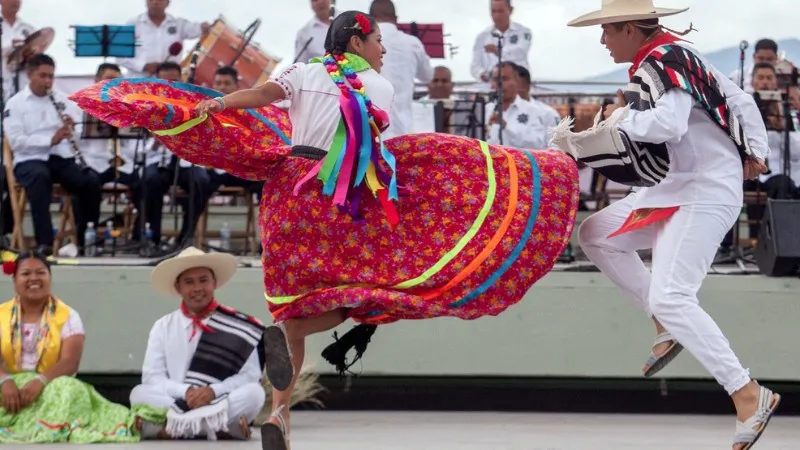
Guelaguetza is a traditional and culturally significant festival celebrated in Oaxaca. This annual event is a vibrant display of indigenous heritage and a celebration of diversity and unity among Oaxaca’s various ethnic groups.
The word “Guelaguetza” originates from the Zapotec language and can be roughly translated as “reciprocal exchange of gifts and services.” The festival typically takes place during the last two Mondays of July, attracting thousands of locals and tourists alike.
One of the highlights of Guelaguetza is the captivating folkloric dance performances, where participants, dressed in colorful and elaborate traditional costumes, showcase their unique regional dances. Each dance carries its own symbolic meaning, often depicting historical events, agricultural rituals, or celebrations of nature.
The festival also features an array of lively music, showcasing the diverse traditional instruments of Oaxaca, such as the marimba, drums, and wind instruments. The melodic tunes create an enchanting atmosphere that adds to the festive spirit of the event.
Central to the Guelaguetza is the “Lunes del Cerro” or “Mondays on the Hill” ceremony, held at the historic Auditorio Guelaguetza on Cerro del Fortin, overlooking the city of Oaxaca. During this main performance, representatives from different indigenous communities come together to share their customs and traditions through dance and music.
Guelaguetza is more than just a cultural festival; it is a symbol of unity and solidarity among Oaxaca’s diverse ethnic groups. It fosters a sense of pride and identity in local communities, preserving and promoting the region’s indigenous heritage.
The festival has also become an essential aspect of Oaxaca’s tourism, drawing visitors from around the world who wish to experience the richness and vibrancy of its cultural expressions.
In recent years, Guelaguetza has evolved to include other cultural events and activities, extending its duration beyond the traditional Mondays. Today, it is a dynamic and evolving celebration that continues to uphold the spirit of reciprocity and cultural exchange that has defined it for generations.
Oaxacan Guelaguetza is a captivating and culturally significant festival that showcases the diverse and vibrant traditions of Oaxaca’s indigenous communities.
Through its music, dance, and spirit of reciprocity, Guelaguetza serves as a testament to the enduring cultural heritage and unity that define this remarkable region of Mexico.
Amazing things Oaxaca is known for
12. Zapotec and Mixtec Cultures
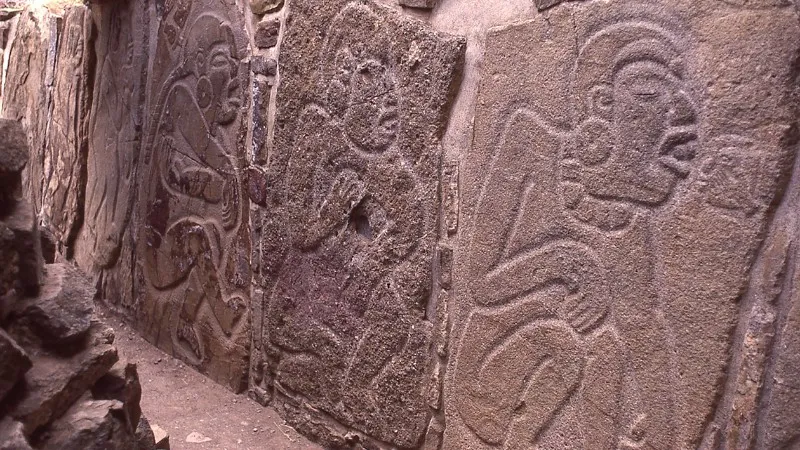
The Zapotec and Mixtec cultures are two prominent indigenous groups in Oaxaca, known for their rich and ancient traditions that have deeply shaped the region’s history and cultural identity.
The Zapotec civilization is one of the oldest Mesoamerican cultures, with roots dating back over 2,500 years.
The Zapotecs inhabited the Oaxaca Valley and surrounding areas, leaving behind impressive archaeological sites such as Monte Albán, which served as their political and religious center.
Their architectural achievements and intricate artistic expressions have made them an essential part of Mesoamerican history.
The Mixtec civilization emerged later in the region, around the 9th century AD.
Like the Zapotecs, the Mixtecs were known for their sophisticated craftsmanship, particularly their intricate codices and ornate goldsmithing. They established a powerful kingdom, with centers like Tilantongo and Tututepec, and maintained extensive trade networks with neighboring cultures.
Both the Zapotec and Mixtec cultures possess rich oral traditions, which have been passed down through generations. Their languages, Zapotec and Mixtec, are still spoken by communities today, preserving their ancient linguistic heritage.
Traditional clothing remains an important aspect of their cultural identity. The Zapotec and Mixtec communities take pride in their distinct clothing styles, which often vary between different villages and regions.
These colorful garments are woven by hand and showcase intricate patterns and designs, symbolizing their unique heritage.
Religion and spirituality hold significant importance for both cultures. They have traditional beliefs that intertwine with Catholic practices brought by Spanish colonization. Festivals, ceremonies, and rituals are central to their religious expressions, often involving music, dance, and offerings to deities.
Today, many Zapotec and Mixtec communities maintain their traditional way of life, relying on agriculture and handicrafts for sustenance and income. Their contributions to Oaxacan culture are celebrated during events like the Guelaguetza, where they showcase their vibrant folkloric dances and music.
Amazing things Oaxaca is known for
13. Artisanal Handicraft

Oaxaca’s artisanal handicraft is a testament to the region’s rich cultural heritage and the skillful craftsmanship of its indigenous communities. Known for their intricate designs and vibrant colors, traditional handicraft is an essential part of Oaxacan culture, reflecting the deep-rooted artistic traditions passed down through generations.
One of the most iconic examples of handicraft from Oaxaca is the exquisite handwoven textiles. Skilled artisans use traditional weaving techniques to create intricate patterns and designs on textiles such as rugs, shawls, and clothing. The use of natural dyes from local plants adds to the unique and authentic charm of these textiles.
Oaxacan pottery is another celebrated handicraft, with the barro negro from the town of San Bartolo Coyotepec being particularly renowned. This pottery is crafted using traditional methods, and the distinct black color is achieved through a unique firing process, giving each piece a striking and elegant appearance.
Among the most recognized Oaxacan handicrafts are the whimsical alebrijes, colorful and fantastical wooden creatures intricately carved by talented artisans. Each alebrije is a work of art, reflecting the creativity and imagination of the maker.
Oaxaca is also famous for its vibrant and finely detailed embroidered textiles. From blouses and dresses to tablecloths and napkins, these embroideries showcase the skilled craftsmanship and artistic expression of Oaxacan women.
Other notable handicrafts include beautiful woven baskets, intricately designed silver jewelry, and wooden masks used in traditional dances and festivals.
Artisans often sell their creations at local markets, such as the bustling Benito Juárez Market in Oaxaca City. These markets provide a vibrant and colorful display of Oaxacan handicrafts, attracting both locals and tourists seeking to appreciate and purchase these one-of-a-kind treasures.
Oaxacan handicrafts play a vital role in the economic and cultural identity of the region, with many communities relying on the craft industry for their livelihoods. The preservation of these artistic traditions is of utmost importance, and efforts are made to promote and support local artisans in their craft.
Oaxacan artisanal handicrafts are a true reflection of the region’s cultural richness and the skillful craftsmanship of its artisans. From handwoven textiles to intricate pottery and unique alebrijes, these traditional crafts are a source of pride for Oaxacan communities and a captivating expression of their cultural heritage.
Amazing things Oaxaca is known for
14. Mitla
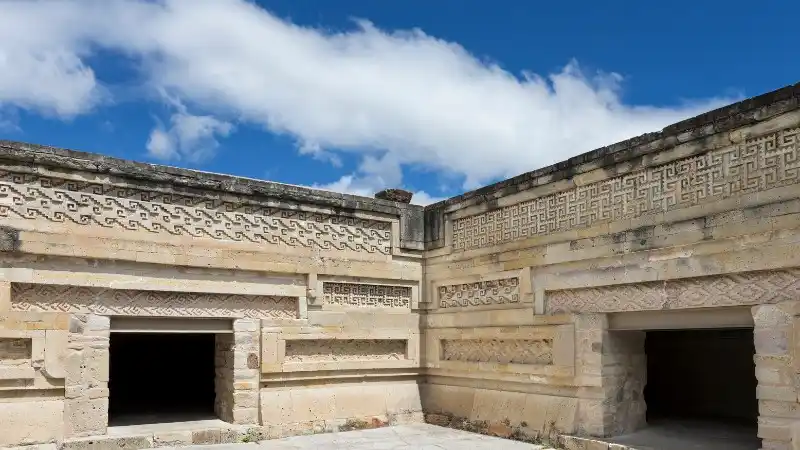
Mitla is an ancient archaeological site located in the Oaxaca Valley of Mexico, approximately 44 kilometers (27 miles) southeast of the city of Oaxaca. The site is renowned for its well-preserved and intricate mosaics, making it one of the most significant archaeological zones in the region.
The origins of Mitla can be traced back to around 900-1000 AD when the Zapotec civilization established the site as a religious and ceremonial center. Later, the Mixtec people occupied Mitla and expanded upon the existing structures, incorporating their architectural style and artistic elements.
The name “Mitla” comes from the Nahuatl word “Mictlan,” which means “place of the dead” or “underworld.” This name was given to the site by the Aztecs, who believed that Mitla was a place where the spirits of the deceased resided.
One of the most distinctive features of Mitla is its unique mosaics, known as grecas. These intricate and decorative patterns are composed of finely cut and fitted stones without the use of mortar. The grecas adorn the walls and panels of the structures, adding a remarkable aesthetic to the architectural design.
The site contains several important structures, including the Group of the Columns, the Group of the Church, the Group of the Adobes, and the South Group. Each complex showcases the sophisticated architectural style and intricate mosaics that define Mitla.
The main building in the Group of the Columns is known as the Hall of Columns, featuring an array of ornate columns with intricate mosaics adorning its walls. It is believed that this building served as a place of residence for the elite or as a ceremonial hall.
The Church, located in the Group of the Church, is the largest and most complex building at Mitla. It has a unique facade with a variety of grecas and intricate stone reliefs, representing both Zapotec and Mixtec artistic influences.
Mitla’s impressive architectural and artistic achievements offer invaluable insights into the religious and ceremonial practices of the Zapotec and Mixtec civilizations. The site was declared a UNESCO World Heritage Site in 1988, recognizing its cultural significance and the need for its preservation.
Today, Mitla is a popular tourist destination, attracting visitors from around the world who come to explore the well-preserved ruins and marvel at the ancient craftsmanship on display.
Guided tours and interpretive signs provide visitors with an understanding of the historical and cultural importance of Mitla in the context of Oaxaca’s rich archaeological heritage.
Amazing things Oaxaca is known for
15. Beaches

Oaxaca is known for its rich cultural heritage and stunning landscapes, however, it is also famous for its beautiful and diverse coastline. The region boasts a series of pristine beaches along the Pacific Ocean, offering visitors a chance to unwind in a tranquil and picturesque setting.
One of the most popular beach destinations in Oaxaca is Puerto Escondido, renowned for its world-class surfing opportunities.
Playa Zicatela, often referred to as the “Mexican Pipeline,” attracts surfers from around the globe with its powerful waves and challenging breaks. For those seeking a more laid-back beach experience, nearby beaches like Playa Carrizalillo and Playa Manzanillo offer calmer waters and a relaxing atmosphere.
Further to the west, Mazunte and Zipolite are two beach towns that offer a more bohemian and eco-friendly vibe.
Mazunte is home to the National Mexican Turtle Center, where visitors can learn about turtle conservation efforts and witness the release of baby turtles into the ocean. Zipolite, on the other hand, is known for being one of the few nudist beaches in Mexico and is popular among free-spirited travelers.
For a more secluded and off-the-beaten-path experience, the beaches of Huatulco are a hidden gem. Huatulco is a series of nine bays and 36 pristine beaches, many of which are accessible only by boat.
These unspoiled beaches offer crystal-clear waters and are perfect for snorkeling, swimming, and simply enjoying the serenity of nature.
The state of Oaxaca is also home to several ecological reserves and national parks that boast stunning beaches. For example, in the Huatulco region, the Huatulco National Park protects several beautiful beaches and coral reefs, making it an excellent spot for ecotourism and marine activities.
Oaxaca’s beaches are not only places of leisure and recreation but also hubs of biodiversity and ecological significance. The coastal areas provide crucial nesting grounds for sea turtles, and conservation efforts are in place to protect these endangered species.
Whether it’s surfing the impressive waves of Puerto Escondido, exploring the eco-friendly towns of Mazunte and Zipolite, or discovering the secluded coves of Huatulco, Oaxaca’s beaches provide a perfect escape to unwind and immerse oneself in the splendor of Mexico’s Pacific coastline.
Amazing things Oaxaca is known for
16. Markets
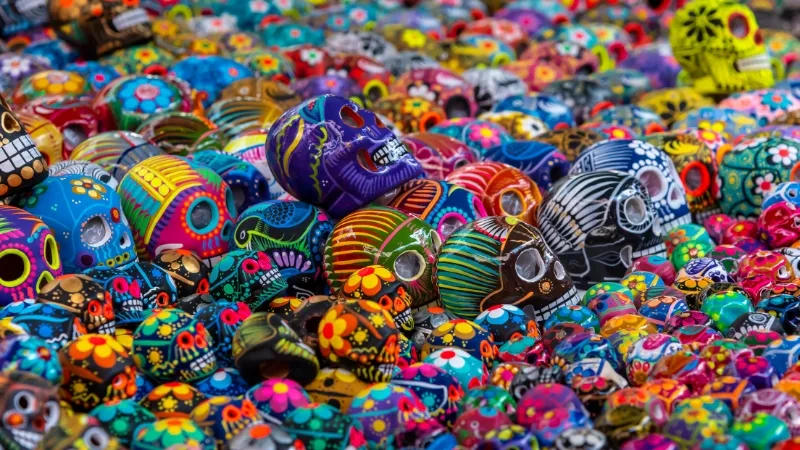
Oaxacan folk art and handicraft markets are vibrant hubs of creativity and cultural expression, offering visitors an immersive experience into the rich artistic traditions of the region.
These markets serve as essential gathering places for local artisans to showcase their talents and offer a wide array of unique and authentic handcrafted goods.
One of the most famous markets in Oaxaca is the Mercado de Artesanías (Craft Market) at the Plaza de la Danza in Oaxaca City.
This bustling market is a treasure trove of Oaxacan folk art, featuring an impressive selection of handwoven textiles, intricate pottery, colorful alebrijes, and exquisite silver jewelry. Visitors can explore stall after stall, each offering a captivating display of traditional craftsmanship.
Another renowned market is the Mercado de Benito Juárez, also located in Oaxaca City.
This expansive market is a vibrant and lively destination where visitors can find a wide range of handicrafts, including embroidered textiles, woven baskets, and wooden masks. It is an excellent place to witness the diversity of Oaxacan folk art, with artisans from various regions showcasing their distinct styles.
Beyond Oaxaca City, many smaller towns and villages host their own weekly or daily markets, each featuring unique local handicrafts. For example, in Teotitlán del Valle, known for its handwoven rugs and textiles, visitors can find an array of beautiful pieces made using traditional Zapotec designs and natural dyes.
The markets not only offer an opportunity for artisans to earn a livelihood from their craft but also serve as cultural hubs where traditional techniques are preserved and passed down through generations. Many artisans learn their skills from family members or local community workshops, maintaining the authenticity and uniqueness of Oaxacan folk art.
In addition to being a treat for the eyes, these markets are a sensory delight, with the aroma of freshly cooked traditional foods wafting through the air. Local delicacies such as tlayudas, empanadas, and various Oaxacan moles add to the vibrant atmosphere, providing a complete cultural experience.
While Oaxacan folk art markets are a significant draw for tourists, they also play a crucial role in supporting the local economy and preserving indigenous cultural heritage. By purchasing handcrafted goods directly from artisans, visitors contribute to the sustainable growth of the craft industry and support the livelihoods of Oaxacan communities.
Oaxacan folk art and handicraft markets are lively showcases of the region’s artistic talents and cultural heritage. These vibrant markets offer visitors a chance to immerse themselves in the rich traditions of Oaxaca through a diverse array of handcrafted goods, creating a memorable and authentic experience of the region’s cultural legacy.
Amazing things Oaxaca is known for
17. Cultural Diversity

Oaxaca’s cultural diversity is a characteristic that Oaxaca is famous for, as it is one of the most culturally rich and vibrant regions in Mexico.
Home to over 16 indigenous ethnic groups, Oaxaca boasts a tapestry of traditions, languages, and customs that have been preserved and celebrated for centuries.
The indigenous communities in Oaxaca have deep-rooted connections to their ancestral lands and maintain their unique languages and customs.
Each ethnic group, such as the Zapotec, Mixtec, Mazatec, and Mixe, possesses its distinct cultural identity, expressed through art, music, dance, and religious practices.
Throughout the year, Oaxaca comes alive with colorful festivals and traditional celebrations, providing visitors with a window into the diverse cultures that thrive in the region.
The Guelaguetza, a major annual cultural event, showcases the music, dance, and vibrant costumes of various indigenous communities, emphasizing the spirit of unity and cultural exchange.
Artisanal crafts, such as handwoven textiles, pottery, and intricate wood carvings, are another reflection of Oaxaca’s cultural diversity. These traditional handicrafts are not only works of art but also significant economic activities for many communities, passed down through generations as a way of preserving cultural heritage.
Oaxaca’s cuisine is also a testament to its cultural diversity. Each region and community in Oaxaca has its culinary specialties, ranging from the rich and complex moles to the hearty tlayudas and delicious street food like tamales and memelas.
The use of local ingredients and traditional cooking methods is deeply ingrained in Oaxacan gastronomy, offering a delectable fusion of flavors.
Religion and spirituality are integral parts of Oaxaca’s cultural fabric, where Catholicism blends harmoniously with ancient indigenous beliefs and practices. Festivals and rituals often incorporate elements of both, creating a unique blend that is characteristic of Oaxacan culture.
Oaxaca’s cultural diversity is also evident in its languages, with more than a third of the population speaking an indigenous language alongside Spanish. Efforts are made to preserve and promote these languages through bilingual education and cultural programs.
The state’s cultural diversity extends to its urban centers, such as Oaxaca City, and its remote rural villages. Each place has its distinct character and charm, offering visitors a diverse range of experiences that showcase the beauty and complexity of Oaxacan culture.
Oaxaca’s cultural diversity is a source of immense pride and a defining feature of the region. The rich tapestry of indigenous communities, languages, traditions, and gastronomy creates a vibrant and enchanting cultural landscape that continues to captivate visitors from around the world.
Oaxaca’s commitment to preserving and celebrating its diverse heritage ensures that its cultural legacy will endure for generations to come.
Amazing things Oaxaca is known for
18. Oaxacan Art

Oaxaca is a thriving hub of artistic expression, and its art galleries and studios offer visitors a unique opportunity to explore the diverse and vibrant world of Oaxacan art. From traditional crafts to contemporary masterpieces, Oaxaca is known for being a treasure trove of creativity and cultural heritage.
The art scene in Oaxaca is deeply rooted in the region’s rich cultural history and indigenous traditions. Many artists draw inspiration from the ancient Zapotec and Mixtec civilizations, incorporating elements of pre-Columbian art and symbolism into their work.
One of the most renowned art galleries in Oaxaca is the Museo de Arte Contemporáneo de Oaxaca (MACO). This contemporary art museum features a collection of both national and international artists, showcasing a wide range of artistic styles and mediums.
MACO also hosts rotating exhibitions and cultural events, making it a dynamic and engaging space for art enthusiasts.
For those interested in traditional Oaxacan crafts, the Instituto de Artes Gráficas de Oaxaca (IAGO) is a must-visit. This institute is dedicated to preserving and promoting traditional printmaking techniques, and its gallery displays a rich collection of prints created by local artisans.
The city’s vibrant street art scene is also worth exploring, with colorful murals adorning many buildings throughout Oaxaca. Street art often reflects social and political issues, as well as celebrating the region’s cultural heritage.
Oaxaca is also home to numerous art studios, where visitors can witness artists at work and purchase original pieces directly from the creators. These studios offer a unique opportunity to engage with artists, learn about their creative process, and acquire one-of-a-kind artworks.
In addition to contemporary and traditional art, Oaxaca is renowned for its craftsmanship in the form of alebrijes, wooden folk art sculptures of fantastical creatures. Visitors can explore workshops where skilled artisans carve and paint these fantastic figures, keeping alive a centuries-old craft.
Throughout the year, Oaxaca hosts various art festivals and cultural events that celebrate the region’s artistic heritage. The annual Oaxaca FilmFest, for instance, showcases a wide selection of international and Mexican films, attracting filmmakers and cinephiles from around the world.
Oaxaca’s art galleries and studios are not limited to the city itself; nearby towns and villages also boast artistic communities. In San Bartolo Coyotepec, for example, visitors can witness the art of barro negro, while Teotitlán del Valle is renowned for its handwoven rugs and textiles.
From contemporary art to traditional crafts, Oaxaca’s artistic offerings provide a fascinating glimpse into the diverse and vibrant world of Oaxacan art, captivating visitors with its beauty and cultural significance.
Amazing things Oaxaca is known for
19. Street Food
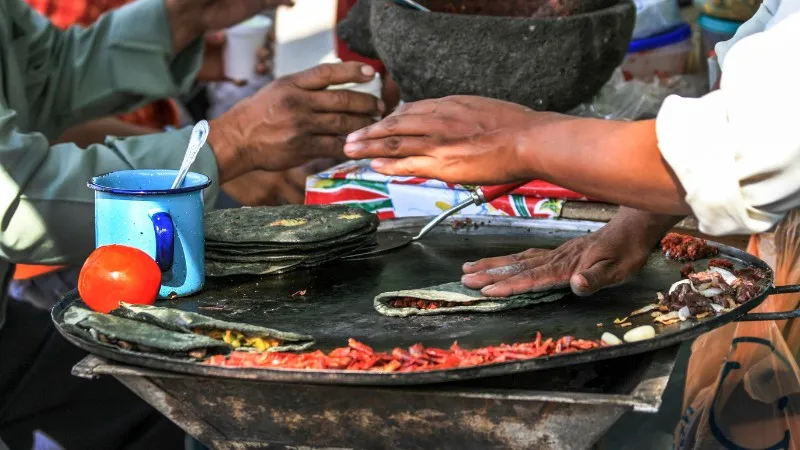
Oaxacan street food is a culinary delight that captivates both locals and visitors with its vibrant flavors and rich cultural heritage.
The streets of Oaxaca are lined with food stalls and carts, offering an array of mouthwatering dishes that showcase the region’s diverse gastronomy.
One of the most beloved street food items in Oaxaca is the tlayuda. Often referred to as “Oaxacan pizza,” the tlayuda is a large, thin, and crispy tortilla topped with beans, Oaxacan cheese, asiento (pork lard), and a choice of meat such as tasajo (thinly sliced beef) or chorizo.
The tlayuda is typically served open-faced and can be customized with an assortment of toppings, including avocado, lettuce, and salsa.
Another popular street food favorite is the memela, a thicker tortilla topped with beans, cheese, and salsa. Memelas are often served as a quick and satisfying snack or as a meal accompanied by a side of cecina (cured pork) or chorizo.
For a burst of flavors, Oaxaca’s street food scene also offers empanadas, turnovers filled with a variety of savory fillings such as cheese, chicken, or flor de calabaza (squash blossoms). Empanadas are commonly enjoyed as a quick and satisfying meal on the go.
Tamales are a staple of Oaxacan street food, with various types to choose from, including tamales de mole, tamales de rajas (with chilies), and tamales de chepil (with a local herb). These steamed parcels of corn dough filled with savory or sweet fillings are a beloved snack throughout the day.
Oaxaca is famous for its diverse selection of moles, and you can find street vendors selling small portions of mole served with chicken or tlayudas. This allows visitors to sample the variety of moles available in the region, each with its distinct blend of chilies, spices, and chocolate.
Sweet treats are abundant in Oaxacan street food, with stalls offering favorites such as nieves (fruit-flavored ice creams), buñuelos (thin, crispy pastries), and tejate, a traditional pre-Hispanic drink made from cacao, maize, and rosita de cacao flowers.
Mezcal, the iconic spirit of Oaxaca, is often found at street food stands, where vendors offer small cups of this traditional agave-based liquor for tasting. It is a unique opportunity for visitors to sample the various flavors and complexities of Oaxacan mezcal.
The diversity and richness of Oaxacan street food make it an integral part of the region’s culinary identity. For both locals and travelers, indulging in Oaxacan street food is an authentic and delightful experience, providing a taste of the region’s culture, history, and vibrant culinary traditions.
Amazing things Oaxaca is known for
20. Architecture
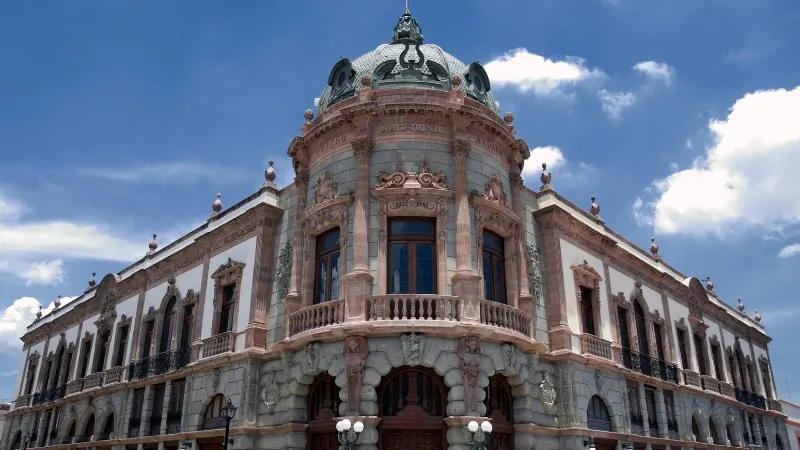
Oaxaca’s architectural heritage is a captivating blend of indigenous, colonial, and modern influences, reflecting the region’s rich history and cultural diversity.
The city of Oaxaca, in particular, is a treasure trove of architectural wonders, boasting well-preserved colonial buildings, ancient archaeological sites, and contemporary structures that coexist harmoniously.
One of the most prominent architectural features of Oaxaca is its colonial buildings, dating back to the 16th century when the Spanish arrived in the region.
The historic center of Oaxaca City, a designated UNESCO World Heritage Site, is characterized by its well-preserved colonial architecture, with elegant facades, arched arcades, and ornate balconies adorning the buildings.
The Cathedral of Our Lady of the Assumption, built in the 16th century, is a striking example of Spanish Baroque architecture and is a prominent landmark in the city.
Ancient architectural wonders are also found throughout Oaxaca, with numerous archaeological sites preserving the legacy of ancient civilizations.
Monte Albán, the ancient Zapotec capital, is renowned for its well-planned layout, pyramids, and ceremonial platforms. The Mitla archaeological site, another significant Zapotec and Mixtec center, features intricate stone mosaics that showcase the advanced engineering and artistic skills of the ancient inhabitants.
Beyond the colonial and ancient architecture, Oaxaca is also home to modern architectural gems that contribute to the city’s urban landscape.
The Rufino Tamayo Museum of Pre-Hispanic Art, designed by Mexican architect Teodoro González de León, is an impressive example of contemporary architecture that houses a vast collection of pre-Hispanic art.
Traditional indigenous architecture remains an essential part of Oaxaca’s architectural heritage. In rural villages, traditional adobe and thatch-roofed houses are still common, reflecting the centuries-old building techniques and local materials used by indigenous communities.
Throughout Oaxaca, efforts are made to preserve and protect its architectural heritage. Strict building regulations are enforced in the historic center of Oaxaca City to maintain the colonial charm and integrity of the area.
Restoration projects are also carried out to preserve and rehabilitate ancient structures and archaeological sites, ensuring that future generations can continue to appreciate the architectural legacy of the region.
Oaxaca’s architectural heritage is not confined to grand structures alone. It is also evident in the many public spaces, plazas, and ornate fountains that adorn the city.
These elements contribute to the overall atmosphere and charm of Oaxaca, creating a unique and immersive experience for both residents and visitors.
Oaxaca’s architectural heritage is a captivating reflection of its history, culture, and diversity. The fusion of colonial, ancient, and modern influences creates a visually stunning and culturally significant landscape that serves as a testament to the region’s enduring legacy.
From the majestic colonial buildings of Oaxaca City to the ancient pyramids of Monte Albán, Oaxaca’s architectural heritage offers a fascinating journey through time and a glimpse into the region’s rich cultural tapestry.
Amazing things Oaxaca is known for
21. Noche de Rábanos

Radish Night, also known as Noche de Rábanos, is an annual and unique cultural event celebrated in Oaxaca on December 23rd. This traditional festival has its roots in the colonial period and has become one of the most popular and anticipated celebrations for which Oaxaca is known.
The origins of Radish Night date back to the 16th century when Spanish merchants introduced radishes to Oaxaca as a staple crop.
Over time, the local artisans and farmers discovered that the region’s fertile soil and climate were ideal for cultivating unusually large radishes. As a result, they began crafting intricate and elaborate carvings using these oversized radishes.
The festival has evolved to become a creative and artistic expression of Oaxaca’s cultural heritage.
On Radish Night, the main square, or Zócalo, of Oaxaca City is transformed into a vibrant and colorful display of radish art. Local artisans, farmers, and individuals compete in a friendly competition to showcase their meticulously carved radish sculptures.
The radish sculptures depict a wide array of themes, including religious scenes, historical events, local legends, and iconic Oaxacan imagery.
The carvings often feature figures such as animals, saints, musicians, and traditional characters from folklore. The intricate details and creativity displayed in each sculpture are a testament to the skill and craftsmanship of the participants.
During Radish Night, thousands of visitors and locals gather in the Zócalo to admire the radish displays and participate in the festivities. The event also includes live music, folkloric dances, traditional food stalls, and cultural performances, creating a vibrant and lively atmosphere.
The competition begins in the early afternoon, and as the sun sets, the radish sculptures are illuminated, enhancing their visual impact and adding to the festive ambiance. The celebration culminates in the announcement of the winners, who are awarded prizes for their exceptional creations.
This unusual event is not only a celebration of creativity and artistic talent but also a tribute to Oaxaca’s agricultural heritage and cultural traditions. It provides a unique opportunity for both locals and visitors to immerse themselves in the region’s vibrant culture and witness the beauty of this remarkable and centuries-old tradition.
Radish Night in Oaxaca is a cherished and cherished annual event that brings together communities to celebrate their cultural identity and showcase their artistic prowess through the whimsical and extraordinary medium of radish carvings. The festival serves as a testament to Oaxaca’s rich and diverse heritage, offering a captivating and unforgettable experience for all who attend.
Amazing things Oaxaca is known for
22. Fiesta de la Virgen de la Soledad

The Fiesta de la Virgen de la Soledad, also known as the Feast of Our Lady of Solitude, is one of the most significant religious and cultural celebrations in the state of Oaxaca, Mexico. Held annually on December 18th, this vibrant festival honors the patron saint of Oaxaca, the Virgen de la Soledad.
The origins of the Fiesta de la Virgen de la Soledad can be traced back to the 17th century when a statue of the Virgin Mary, carved in Guatemala, was brought to Oaxaca. The statue depicts the Virgin in mourning, with her son, Jesus, in her arms. It is believed that the Virgin of Solitude provides comfort and solace to those in times of sorrow and grief.
The festival commences with a series of religious ceremonies and processions, beginning on December 15th. Devotees gather at the Basilica of Our Lady of Solitude in Oaxaca City to participate in prayers, hymns, and Masses dedicated to the Virgin Mary. The celebrations are attended by both locals and visitors, creating a vibrant and festive atmosphere throughout the city.
On the eve of December 18th, the statue of the Virgin Mary is paraded through the streets of Oaxaca in a grand procession. The image is carried by devotees in a solemn and reverent manner, accompanied by traditional music, singing, and dancing. The streets are adorned with colorful decorations, flowers, and candles, creating a visually stunning and spiritually charged ambiance.
As the procession makes its way through the city, devotees offer flowers, candles, and gifts to the Virgin as acts of devotion and gratitude. The atmosphere is filled with emotion and a deep sense of faith as people come together to honor their patron saint and seek her blessings.
The Fiesta de la Virgen de la Soledad is not only a religious event but also a celebration of Oaxacan culture and identity. Throughout the festivities, traditional music, dance, and regional cuisine are showcased, reflecting the region’s rich cultural heritage.
The festival provides a unique opportunity for visitors to immerse themselves in Oaxacan traditions and experience the warmth and hospitality of the local community.
The Fiesta de la Virgen de la Soledad is a solemn yet vibrant celebration that holds deep religious and cultural significance for the people of Oaxaca. This annual festival brings together faith, tradition, and community in a grand display of devotion and celebration, making it an unforgettable and cherished experience for both participants and observers.
Amazing things Oaxaca is known for
23. Alebrijes

Alebrijes are fantastical and colorful sculptures that have become an iconic part of Mexican folk art, particularly in the state of Oaxaca. These whimsical creatures are handcrafted from copal wood and are known for their intricate designs and vibrant hues.
The origin of alebrijes can be traced back to the 1930s, when Mexican artist Pedro Linares, inspired by a feverish dream, began creating the first alebrijes. In his dream, Linares saw a fantastical menagerie of creatures with various animal parts and fantastical features. He brought these creatures to life through his art, using papier-mâché and later transitioning to carving copal wood.
Alebrijes are traditionally carved by hand using simple tools, such as knives and chisels. Each piece is a testament to the skill and artistry of the Oaxacan artisans who meticulously carve and shape the wood to create these imaginative creatures.
The designs of alebrijes are often a fusion of various animals, insects, and mythical beings, resulting in unique and captivating sculptures. The creatures are characterized by intricate patterns and details, painted in an array of vivid colors that further enhance their whimsical nature.
The process of making alebrijes is a labor-intensive one, requiring a keen eye for detail and a deep understanding of the craft. Once carved, the sculptures are sanded, primed, and then painted with acrylic paints. The finishing touches include adding fine details and sometimes attaching additional parts, such as wings or tails.
Originally, alebrijes were created in the towns of San Martín Tilcajete and Arrazola, both located in the Oaxaca region. Over time, the popularity of alebrijes has spread, and they can now be found in other regions of Mexico as well.
Today, alebrijes are not only popular in Mexico but also celebrated internationally as symbols of Mexican folk art and creativity. They have become sought-after collectibles and are displayed in museums, galleries, and private collections worldwide.
In Oaxaca, the craft of making alebrijes has become a significant economic activity, providing livelihoods to many artisan families. The continued appreciation and demand for these unique sculptures have contributed to the preservation of traditional craftsmanship and the promotion of Oaxacan cultural heritage.
Alebrijes are enchanting expressions of Mexican folk art, beloved for their whimsical charm and vibrant colors. These handcrafted sculptures are a testament to the creativity and skill of Oaxacan artisans and a key example of the handicrafts that Oaxaca is known for.
Amazing things Oaxaca is known for
24. Sierra Norte

The Sierra Norte, located in the northern region of Oaxaca, is a stunning and picturesque mountain range known for its breathtaking natural beauty and rich biodiversity. Spanning over 350,000 hectares, this diverse landscape is a haven for eco-tourism, adventure seekers, and nature enthusiasts that Oaxaca is known for.
The Sierra Norte is characterized by its rugged terrain, dense forests, deep canyons, and majestic peaks that reach elevations of up to 3,000 meters (9,800 feet) above sea level.
The region is home to numerous ecological zones, including cloud forests, pine-oak forests, and high-altitude grasslands, each offering a unique and diverse ecosystem.
Visitors to the Sierra Norte can explore an array of outdoor activities and adventures.
Hiking and trekking trails lead to hidden waterfalls, natural pools, and panoramic viewpoints, providing opportunities to immerse in the region’s pristine wilderness. Mountain biking is also popular, with trails that wind through picturesque landscapes.
The Sierra Norte is renowned for its rich biodiversity, making it a paradise for birdwatchers and wildlife enthusiasts. The area is home to a variety of flora and fauna, including numerous species of birds, mammals, and butterflies, some of which are endemic to the region.
One of the notable attractions in the Sierra Norte is the Pueblos Mancomunados, a collective of eight indigenous villages that have come together to promote sustainable tourism and preserve their cultural heritage. Each village offers rustic cabins or eco-lodges for visitors, providing a unique opportunity to experience the local way of life and partake in traditional activities.
Another highlight of the Sierra Norte is the presence of natural hot springs, which offer a relaxing and rejuvenating experience amidst the cool mountain air. These thermal baths are perfect for unwinding after a day of exploration.
Moreover, the Sierra Norte provides excellent opportunities for stargazing due to its clear skies and minimal light pollution, making it an ideal destination for astronomy enthusiasts.
To promote responsible tourism and conservation, various eco-tourism projects and community-based initiatives have been established in the region. Local communities actively participate in preserving the environment and protecting their cultural heritage while providing visitors with unique and sustainable experiences.
The Sierra Norte in Oaxaca is a captivating destination that offers an escape to a natural wonderland that Oaxaca is known for. Its diverse landscapes, abundant wildlife, and cultural richness make it an exceptional place to explore and experience the beauty of Oaxaca’s mountainous region while supporting sustainable tourism initiatives.
Amazing things Oaxaca is famous for
25. Pueblos Mágicos

Oaxaca is home to five enchanting towns that have earned the prestigious title of Pueblos Mágicos (Magical Towns). These towns, each with its own unique charm and allure, offer visitors a truly magical and immersive experience.
Capulalpam de Méndez, nestled amidst the scenic Sierra Norte mountains, exudes a serene ambiance with its cobblestone streets and ancient churches, providing a glimpse into the region’s rich Zapotec culture.
Huautla de Jiménez, located in the Sierra Mazateca region, celebrates its indigenous Mazatec heritage and is famous for traditional healing practices involving hallucinogenic mushrooms, adding a spiritual dimension to its allure.
San Pedro y San Pablo Teposcolula captivates with its impressive colonial architecture and the 16th-century Dominican ex-convent of San Pedro y San Pablo, providing a window into the town’s historical past.
San Pablo Villa de Mitla, renowned for its pre-Hispanic ruins, boasts intricate stone mosaics and designs, offering insights into the fascinating ancient Zapotec civilization.
Mazunte, a coastal paradise, captivates with its stunning beaches and commitment to sustainable tourism, making it an idyllic destination for nature lovers and beach enthusiasts.
The Pueblos Mágicos showcase the diverse cultural tapestry and natural beauty that Oaxaca is known for.
As part of the Pueblos Mágicos program, they receive support from the Mexican government to preserve their unique heritage that Oaxaca is known for and to promote tourism sustainably.
For travelers seeking authentic and unforgettable experiences, a journey to these magical towns promises a captivating and enriching adventure into Oaxaca’s captivating history, culture, and landscapes.
Amazing things Oaxaca is known for
26. Chapulines
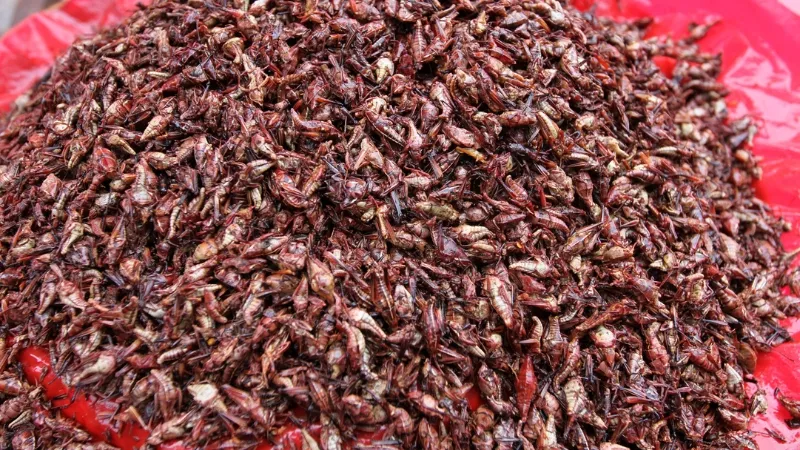
Oaxacan chapulines are a unique and traditional delicacy in Mexican cuisine that Oaxaca is known for.
These edible grasshoppers have been consumed in the region for centuries and hold cultural significance as a nutritious and sustainable food source. Chapulines are enjoyed not only as a snack but also as a culinary ingredient in various dishes.
The chapulines used in Oaxacan cuisine are typically harvested during the rainy season when they are abundant in the fields and meadows. They are carefully collected by hand, ensuring only the right species of grasshoppers are selected for consumption.
The most commonly used species are Sphenarium purpurascens and Sphenarium histrioides, known for their crunchy texture and mild, nutty flavor.
Before being prepared for consumption, the chapulines are thoroughly cleaned to remove any impurities. They are then roasted or toasted over an open flame, which not only enhances their taste but also helps preserve them for extended periods. The traditional roasting process gives chapulines a distinctive smoky flavor, making them a flavorful and aromatic treat.
Chapulines can be enjoyed in various ways, making them a versatile ingredient in Oaxacan cuisine. They are often served as a simple snack, sprinkled with lime juice, salt, and chili powder, providing a delightful combination of tanginess and spice. Some vendors also add garlic, onion, and other spices to create unique flavor profiles.
In addition to being consumed as a snack, chapulines are used to enhance the flavors of other dishes. They can be added to tacos, quesadillas, and tlayudas, contributing an extra crunch and a savory element to these traditional foods.
The use of chapulines in Oaxacan cuisine is not only a testament to the region’s rich culinary heritage but also reflects the resourcefulness and sustainability of the local culture.
Beyond their taste and culinary uses, chapulines are valued for their nutritional benefits. They are a rich source of protein, fiber, vitamins, and minerals, making them a nutritious and energy-packed food source.
In recent years, chapulines have gained attention from the global food industry as an eco-friendly and sustainable protein alternative.
Oaxacan chapulines are an intriguing and culturally significant part of the gastronomy that Oaxaca is known for. Their unique taste, nutritional value, and traditional preparation methods make them a memorable and authentic culinary experience for adventurous food enthusiasts.
Whether enjoyed as a snack or incorporated into dishes, chapulines continue to be cherished as an integral part of the food culture that Oaxaca is known for and an intriguing aspect of Mexico’s diverse culinary heritage.
Amazing things Oaxaca is known for
27. Natural Hot Springs

Oaxaca is known for being home to a number of natural hot springs, known locally as “aguas termales,” which have been cherished for their therapeutic and relaxation properties for centuries. These natural wonders are scattered throughout the region, offering visitors a unique and rejuvenating experience amidst the lush landscapes of Oaxaca.
The hot springs in Oaxaca are the result of geothermal activity, where heated water from deep within the earth rises to the surface, creating pools of warm and mineral-rich water. The water is heated by volcanic activity, and as it moves through the earth’s layers, it picks up valuable minerals such as calcium, magnesium, and sulfur.
These minerals are believed to have various health benefits, including promoting relaxation, improving circulation, and soothing sore muscles and joints.
One of the natural hot springs that Oaxaca is known for is Hierve el Agua, located about 70 kilometers (43 miles) east of Oaxaca.
Hierve el Agua is a unique geological formation, where mineral-rich water flows over the edge of a cliff, creating “petrified” waterfalls and stunning, terrace-like formations. The pools here are not only warm and inviting but also offer breathtaking views of the surrounding valleys and mountains.
Another popular destination for hot springs is the town of San Felipe Usila, situated in the northern region of Oaxaca. The natural hot springs here are tucked away in a remote and pristine area, providing visitors with a serene and tranquil setting to unwind and enjoy the healing properties of the thermal waters.
Oaxacan natural hot springs are not only appreciated for their therapeutic benefits but also for their natural beauty and the sense of harmony they bring with the surrounding environment. Many hot spring locations are set amidst lush forests, meandering rivers, or rugged mountains, allowing visitors to connect with nature and enjoy a moment of peacefulness.
Visiting Oaxacan hot springs is often a family or communal experience, with locals and tourists alike coming together to enjoy the healing waters. Oaxaca is known for its traditional temazcal ceremonies conducted near hot springs, where participants can cleanse their bodies and minds in a sweat lodge, further enhancing the therapeutic experience.
While some hot springs are easily accessible, others require a short hike or a drive through scenic landscapes, adding an element of adventure to the experience. It is essential to be mindful of the natural environment and respect the rules and regulations set by local authorities to preserve these natural wonders for future generations to enjoy.
Oaxacan natural hot springs are a hidden gem that invites visitors to embrace the healing power of geothermal waters while being immersed in the stunning landscapes of the region.
The combination of relaxation, cultural traditions, and natural beauty makes a visit to these hot springs an unforgettable and rejuvenating experience for travelers seeking a deeper connection with Oaxaca’s natural heritage.
Amazing things Oaxaca is known for
28. Oaxacan Coffee

Oaxacan coffee is a gem in the world of specialty coffees, renowned for its exceptional quality, unique flavor profiles, and sustainable farming practices.
Oaxaca’s diverse microclimates, volcanic soil, and high altitudes create the perfect conditions for growing coffee beans with distinct characteristics.
Coffee production in Oaxaca dates back to the 19th century when the plant was first introduced to the region. Since then, coffee cultivation has flourished, becoming an essential part of Oaxaca’s agricultural and economic landscape.
Today, Oaxaca is known for being one of Mexico’s leading coffee producers, with numerous small-scale farmers and cooperatives dedicated to cultivating this prized crop.
One of the significant contributors to Oaxacan coffee’s distinct taste is its elevation. The coffee plants are grown at high altitudes, ranging from 900 to 1,600 meters above sea level.
The cooler temperatures and ample rainfall at these elevations slow down the coffee cherry maturation process, allowing the beans to develop more complex flavors.
The region’s coffee varietals also play a crucial role in shaping Oaxacan coffee’s flavor profiles.
Arabica beans dominate the Oaxacan coffee scene, and within this category, you’ll find a range of unique varieties like Typica, Bourbon, and Mundo Novo. These varieties contribute to the diverse taste experiences offered by Oaxacan coffee, from bright and fruity to nutty and chocolaty.
A defining feature of Oaxacan coffee production is its emphasis on sustainable and organic farming practices.
Many coffee farms in the region are certified organic, eschewing the use of synthetic chemicals and promoting eco-friendly cultivation methods. This commitment to sustainability not only benefits the environment but also enhances the flavor and quality of the coffee beans.
The process of harvesting and processing Oaxacan coffee is often carried out by hand, ensuring careful selection and handling of the coffee cherries. After harvesting, the beans undergo meticulous processing methods, which can include wet, dry, or semi-washed processes.
These various processing techniques contribute to the distinct flavors and aromas found in Oaxacan coffee.
In addition to its exceptional taste, Oaxacan coffee also carries cultural significance for the region. Many local communities have a long-standing tradition of coffee cultivation, passed down through generations.
The coffee industry provides livelihoods to thousands of families and plays a pivotal role in sustaining rural economies.
The popularity of Oaxacan coffee has grown beyond the region’s borders, attracting attention from coffee enthusiasts and connoisseurs worldwide. Many specialty coffee shops and roasters across the globe feature Oaxacan coffee on their menus, celebrating its unique flavors and supporting the sustainable practices of local farmers.
Oaxacan coffee stands as a testament to the region’s commitment to quality, sustainability, and cultural heritage. With its diverse flavor profiles, organic farming practices, and traditional production methods, Oaxacan coffee remains a prized gem in the world of specialty coffees, delighting coffee lovers and supporting local communities in the process.
Amazing things Oaxaca is known for
Final Thoughts
So amazing things that Oaxaca is known for! Believe it or not, the list above barely scratches the surface.
Oaxaca’s cultural heritage, breathtaking landscapes, and vibrant traditions have captivated travelers from all walks of life, leaving an indelible mark on their hearts and minds.
The colorful handicrafts, awe-inspiring art galleries, and traditional festivals all paint a vivid picture of Oaxaca’s lively and dynamic culture.
Oaxaca’s diversity is incredible and takes us from the relaxing hot springs to pristine beaches and majestic mountains. The region’s natural beauty has provided a sense of serenity and wonder, offering a sanctuary for both adventure seekers and those seeking respite from the bustle of everyday life.
Whether you are a food enthusiast, an art lover, a nature admirer, or a culture connoisseur, Oaxaca has something to offer everyone.
We hope that our journey through Oaxaca’s treasures has sparked your curiosity and ignited a desire to explore this remarkable region in person.

![Huatulco to Mexico City: 5 Best Ways To Travel [2024]](https://capricioustravel.com/wp-content/uploads/2024/01/Huatulco-to-Mexico-City-Split-shot-Bahia-la-Entrega-and-the-Metropolitan-Cathedral-800x450.webp)
![Selina Oaxaca: The Definitive Review [2024]](https://capricioustravel.com/wp-content/uploads/2023/11/Selina-Oaxaca-Interior-Wall-Painting-800x450.webp)
![Quinta Real Oaxaca: The Definitive Review [2024]](https://capricioustravel.com/wp-content/uploads/2023/10/Quinta-Real-Oaxaca-Lavaderos-800x450.webp)
![Cancún to Guadalajara: 5 Best Ways to Travel [2024]](https://capricioustravel.com/wp-content/uploads/2024/02/Cancun-to-Guadalajara-The-Cancun-Hotel-Zone-and-the-Guadalajara-Cathedral.webp)
![Hotel Escondido Puerto Escondido: The Definitive Review [2024]](https://capricioustravel.com/wp-content/uploads/2023/10/Hotel-Escondido-Puerto-Escondido-Terrace-at-Sunset-800x450.webp)
![Is Puerto Escondido Safe To Visit? The Ultimate Guide [2024]](https://capricioustravel.com/wp-content/uploads/2023/10/Is-Puerto-Escondido-Safe-800x450.webp)